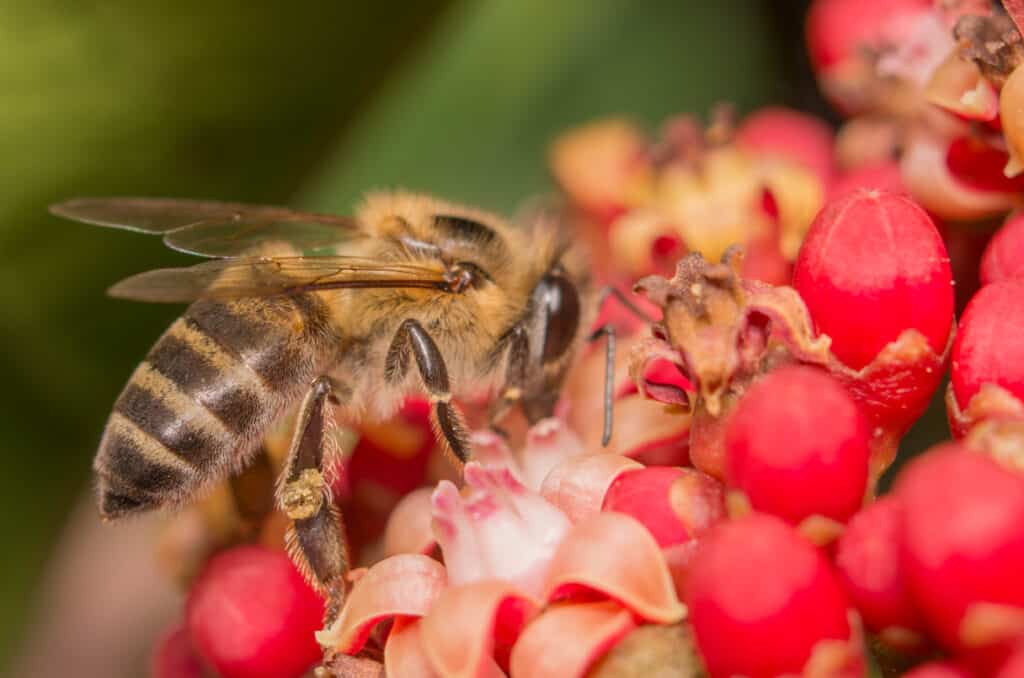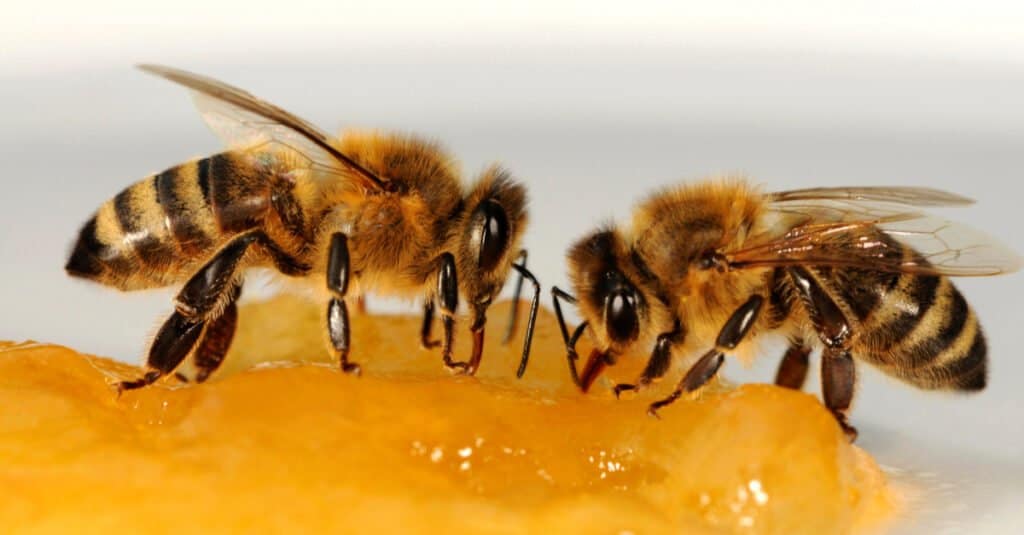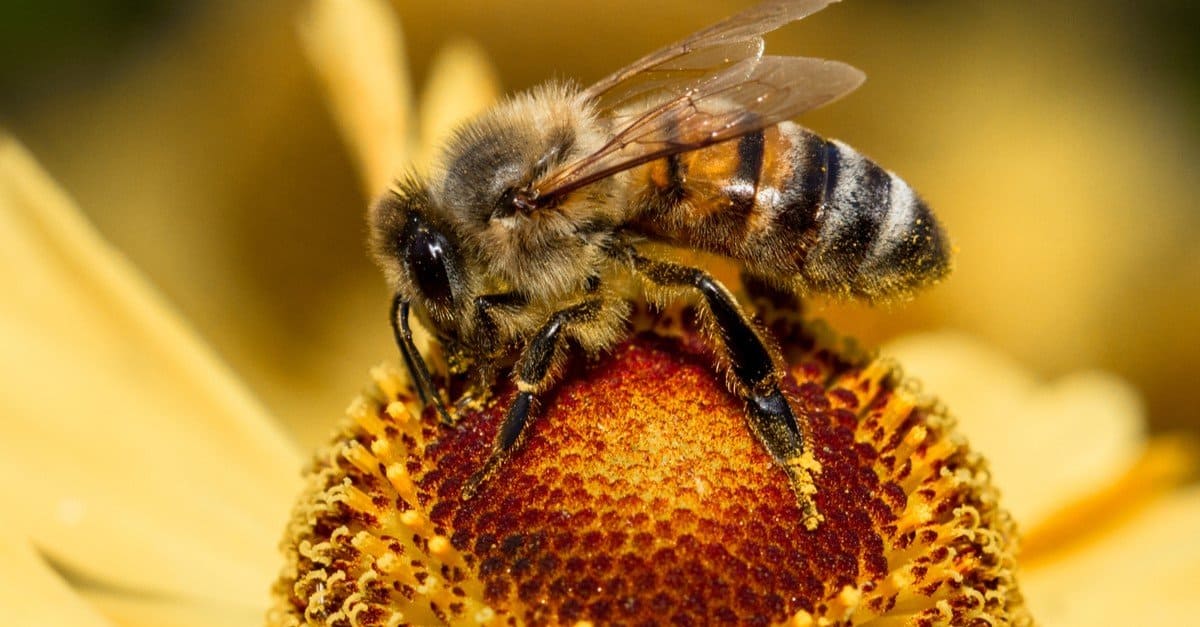Invasive bees sound like unwanted guests that raid your fridge and hog your TV remote. While it’s true that some invasive bees weren’t exactly invited to Florida, others were intentionally brought over and now take an important role in pollinating crops. Instead of raiding your fridge, they’re actually part of the reason you’re able to fill it with fruits and veggies! Below, we’ll highlight four invasive bees buzzing around Florida. Then, we’ll share a bit about native bee species and what you can do to create a bee-friendly garden.
4 Invasive Bees Buzzing Around Florida
1. Green Orchid Bee
Scientific Name: Euglossini
Green orchid bees have a distinctive iridescent metallic luster throughout their bodies and are about the size of the better-known honey bee. When these bees are native to their environment, they engage in a mutually beneficial relationship with a specific orchid species. Orchids in these environments may emit an attractive scent or bloom in a way that mimics the appearance of female bees so the males can pollinate them. They’re native to tropical regions in Central and South America as well as Mexico. Entomologists first spotted them in Florida in 2003 — it’s believed they arrived concealed within a pallet containing imported goods from Mexico.

Green orchid bees have a distinctive iridescent metallic luster throughout their bodies.
©Marco Lissoni/Shutterstock.com
2. Africanized Honey Bee
Scientific Name: Apis mellifera scutellate
Africanized honey bees are subspecies of the honey bees you’re used to seeing. They are native to sub-Saharan Africa but now exist throughout the Americas due to their important roles as pollinators and honey producers. Many efforts were made to breed a gentle and effective species, but unfortunately, the bees swarmed, and efforts were thwarted. They ended up breeding with European bees, which created hybrids now known as Africanized honey bees. It’s not easy to tell them apart from European bees, but they are slightly smaller. Ultimately, measurements of their wing patterns can help with further identification.

Africanized honey bees are subspecies of the honey bees you’re used to seeing.
©Philip Marsden/Shutterstock.com
3. Honey Bee
Scientific Name: Apis
Honey bees are perhaps the most well-known bees in Florida and other states, but they only represent a fraction of bee species. These bees are known for their impressive hives, which they build as a colony using secreted wax. They also produce honey (and store it within their hives) and pollinate crops throughout the U.S. Honey bees are light brown with golden-yellow colorations. They also have brown bands across their oval-shaped bodies. These colors are purposeful, alerting predators that if they get too close, they’re going to get stung. You can usually find honey bees nesting in trees or in the spaces between rocks. However, there are many beekeepers found throughout the state of Florida who provide honey bees with wooden boxes so they can harvest their honey.

Honey bees produce honey (and store it within their hives) and pollinate crops throughout the U.S.
©schubbel/Shutterstock.com
4. Giant Resin Bee
Scientific Name: Megachile sculpturalis
Giant resin bees are native to Asia and have only been in the U.S. since the 90s. They gravitate to plants that grow naturally in their home environment but may also frequent other plants. During their process of collecting nectar or pollen, they create so much damage to flowers that they’re not usable for other bees. These bees have large bodies that are mostly black, including the head. However, their insect hairs are more of a yellow-brown color just below their heads. The females are significantly larger than the males, reaching up to 27 millimeters in length. Aside from the size difference, you can tell the males apart because they have a tiny golden “mustache.”

During their process of collecting nectar or pollen, giant resin bees create so much damage to flowers that they’re not usable for other bees.
© 1000 × 667 pixels • 3.3 × 2.2 in • DPI 300 • JPG 500 × 334 pixels • 1.7 × 1.1 in • DPI 300 • JPG Show more Photo Contributor Wirestock Creators Wirestock Creators/Shutterstock.com
Florida’s Native Bees
While there are some non-native bees found throughout Florida, this state is also home to hundreds of native bees, most of which use the ground as their nesting place. Native bees have important roles as pollinators to ensure plants reproduce. They are part of the healthy ecosystem, and they’re all around you if you’re in Florida. Sometimes, they’re out by the coast enjoying beaches, and sometimes they prefer the comfort of your yard. Native bees come from different primary families and are incredibly diverse. Their colors, sizes, shapes, and fuzz all vary across species.
Create a Bee-Friendly Garden
If you’d like to create an environment that helps native bees the way they help you out, you can consider filling your garden with the types of plants and flowers bees are naturally drawn to. Choose native wildflowers, shrubs, and flowering vines, and keep cultivars and hybrids at a minimum. Bees are attracted to specific colors as well, so add pops of yellow, white, and blue-violet flowers. When planting, group your flowers together and ensure you always have a blooming garden, no matter the time of year. Once your garden is all set up, maintain it but don’t disturb it — the bees are likely to nest in the ground, thanks to your efforts in securing abundant food sources.
Thank you for reading! Have some feedback for us? Contact the AZ Animals editorial team.








